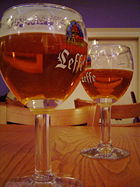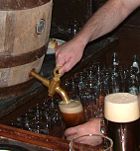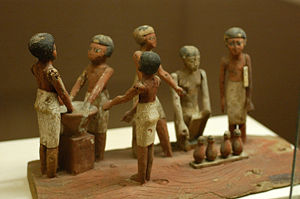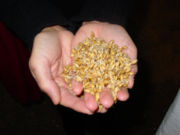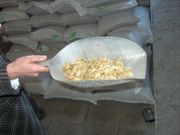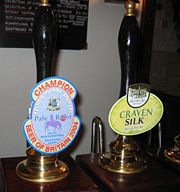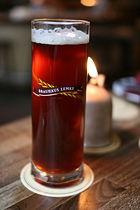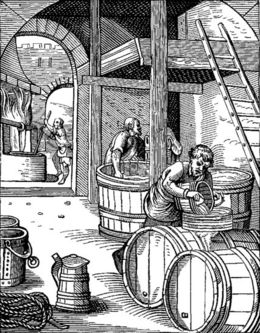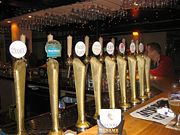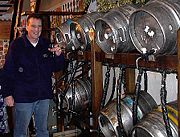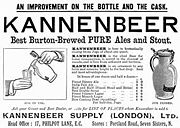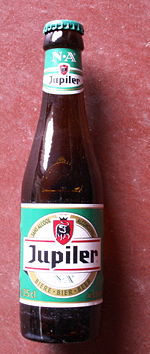Beer
2008/9 Schools Wikipedia Selection. Related subjects: Drink
Beer is an alcoholic beverage produced by brewing and the fermentation of starches derived from cereals. The most common cereal for beer brewing is malted barley, although wheat, corn, and rice are also widely used, usually in conjunction with barley. Most beer is flavoured with hops, which adds a slightly bitter taste and acts as a natural preservative. Occasionally, other ingredients such as herbs or fruit may also be included in the brewing process. Alcoholic beverages fermented from non-starch sources such as grape juice (wine) or honey ( mead) are not classified as beer.
It is the world's oldest and most consumed alcoholic beverage, and the most popular drink overall after water and tea. Some of the earliest known writings refer to the production and distribution of beer: the Code of Hammurabi included laws regulating beer and beer parlors, and "The Hymn to Ninkasi", a prayer to the Mesopotamian Goddess of Beer, served as both a prayer and as a method of remembering the recipe for beer in a culture with few literate people.
History
Beer is one of the world's oldest beverages, possibly dating back to the 6th millennium BC, and is recorded in the written history of ancient Egypt and Mesopotamia. The earliest Sumerian writings contain references to beer. A prayer to the goddess Ninkasi known as "The Hymn to Ninkasi" serves as both a prayer as well as a method of remembering the recipe for beer in a culture with few literate people.
The earliest known chemical evidence of beer dates to circa 3500–3100 BC from the site of Godin Tepe in the Zagros Mountains of western Iran. As almost any substance containing carbohydrates, mainly sugar or starch, can naturally undergo fermentation, it is likely that beer-like beverages were independently invented among various cultures throughout the world. The invention of bread and beer has been argued to be responsible for humanity's ability to develop technology and build civilization.
As for the close link between bread- and beer-making, women produced most beer prior to the introduction of hops in the thirteenth century, selling the beverage from their homes as a means of supplementing the family income. However, by the 7th century AD beer was also being produced and sold by European monasteries. During the Industrial Revolution, the production of beer moved from artisanal manufacture to industrial manufacture, and domestic manufacture ceased to be significant by the end of the 19th century. The development of hydrometers and thermometers changed brewing by allowing the brewer more control of the process, and greater knowledge of the results.
Beer was also known by Slavic tribes in early 5th century.
Ingredients
The basic ingredients of beer are water; a fermentable starch source, such as malted barley; and yeast. It is common for a flavouring to be added, the most popular being hops. A mixture of starch sources may be used, with the secondary starch source, such as corn, rice and sugar, often being termed an adjunct, especially when used as a lower cost substitute for malted barley. Less widely used starch sources include millet, sorghum and cassava root in Africa, potato in Brazil, and agave in Mexico, among others.
Water
Beer is composed mostly of water, and the water used to make beer nearly always comes from a local source. The mineral components of water are important to beer because minerals in the water influence the character of beer made from it. Different regions have water with different mineral components. As a result, different regions are better suited to making certain types of beer. For example, Dublin has hard water well-suited to making stout, such as Guinness, and Pilzen has soft water well-suited to making pale lager, such as Pilsner Urquell. As a result, it is argued that the mineral components of water have an influence on the character of regional beers.
Hops
The flower of the hop vine is used as a flavouring and preservative agent in nearly all beer made today. The flowers themselves are often called "hops". The use of hops in beer was recorded by captive Jews in Babylon around 400 BC. Hops were used by monastery breweries, such as Corvey in Westphalia, Germany, from 822 AD, though the date normally given for widespread cultivation of hops for use in beer is the thirteenth century.
Hops contain several characteristics that brewers desire in beer: hops contribute a bitterness that balances the sweetness of the malt; hops also contribute floral, citrus, and herbal aromas and flavours to beer; hops have an antibiotic effect that favours the activity of brewer's yeast over less desirable microorganisms; and the use of hops aids in " head retention", the length of time that a foamy head created by carbonation will last. The acidity of hops acts as a preservative that—after its introduction—gave brewers the ability to transport their product over longer distances, thereby allowing for the rise to commercial breweries.
The bitterness of beers is measured on the International Bitterness Units scale. Beer is the sole major commercial use of hops.
In the past, other plants have been used for similar purposes; for instance, Glechoma hederacea. Combinations of various aromatic herbs, berries, and even ingredients like wormwood would be combined into a mixture known as gruit and used as hops are now used.
Yeast
Yeast is the microorganism that is responsible for fermentation in beer. Yeast metabolises the sugars extracted from grains, which produces alcohol and carbon dioxide, and thereby turns wort into beer. In addition to fermenting the beer, yeast influences the character and flavour. The dominant types of yeast used to make beer are ale yeast ( Saccharomyces cerevisiae) and lager yeast ( Saccharomyces uvarum); their use distinguishes ale and lager. Brettanomyces ferments lambics, and Torulaspora delbrueckii ferments Bavarian weissbier. Before the role of yeast in fermentation was understood, fermentation involved wild or airborne yeasts. A few styles such as lambics rely on this method today, but most modern fermentation adds pure yeast cultures directly to wort.
Clarifying agent
Some brewers add one or more clarifying agents to beer, which typically precipitate out of the beer along with protein solids and are found only in trace amounts in the finished product. Common examples of these include isinglass finings, obtained from swimbladders of fish; Irish moss, a seaweed; kappa carrageenan, from the seaweed Kappaphycus cottonii; Polyclar (artificial); and gelatin. If a beer is marked 'suitable for Vegans' then it has either been clarified with seaweed or with artificial agents.
Types and styles of beer
A great many beers are brewed across the globe. Local traditions will give beers different names, giving the impression of a multitude of different styles. However, the basics of brewing beer are shared across national and cultural boundaries.
The late British beer writer Michael Jackson wrote about beers from around the world in his 1977 book The World Guide To Beer and organised them into local style groups based on local information. This book had an influence on homebrewers in United States who developed an intricate system of categorising beers which is exemplified by the Beer Judge Certification Program.
The traditional European brewing regions—Germany, Belgium, the United Kingdom, Ireland, Poland, the Czech Republic, Denmark, The Netherlands and Austria—have local varieties of beer. In some countries, notably the USA, Canada and Australia, brewers have adapted European styles to such an extent that they have effectively created their own indigenous types.
Categorising by yeast
The most common method of categorising beer is by the behaviour of the yeast used in the fermentation process. In this method of categorising, those beers which use a fast-acting yeast, which leaves behind residual sugars, are termed ales, while those beers which use a slower and longer acting yeast, which removes most of the sugars, leaving a clean and dry beer, are termed lagers.
Differences between some ales and lagers can be difficult to categorise. Steam beer, Kölsch, Alt, and some modern British Golden Summer Beers use elements of both lager and ale production. Baltic Porter and Bière de Garde may be produced by either lager or ale methods or a combination of both. However, lager production results in a cleaner tasting, drier and lighter beer than ale.
Ale
A modern ale is commonly defined by the strain of yeast used and the fermenting temperature.
Ales are normally brewed with top-fermenting yeasts (most commonly Saccharomyces cerevisiae), though a number of British brewers, including Fullers and Weltons, use ale yeast strains that have less pronounced top-fermentation characteristics. The important distinction for ales is that they are fermented at higher temperatures and thus ferment more quickly than lagers.
Ale is typically fermented at temperatures between 15 and 24 °C (60 and 75 °F). At these temperatures, yeast produces significant amounts of esters and other secondary flavour and aroma products, and the result is often a beer with slightly "fruity" compounds resembling apple, pear, pineapple, banana, plum, or prune, among others. Typical ales have a sweeter, fuller body than lagers.
A particularly well-known ale type is India Pale Ale (or "IPA"), developed by British brewers in the 19th century. The ale was light, and suited to a hot climate, but with a moderately high alcohol strength and strong hop content, intended to preserve it over a long ocean voyage. Some mass-produced beers (e.g. Alexander Keith's, brewed in Halifax, Nova Scotia, Canada) use the term "India Pale Ale", but are not in any way true IPAs.
Real ale is a natural product brewed using traditional ingredients and left to mature in the cask (container) from which it is served through a process called secondary fermentation where the beer slowly ferments in its cask producing its own natural CO2. This causes a build up of pressure in the cask which literally forces it out of the barrel when it is being poured.
Lager

Lager is the English name for bottom-fermenting beers of Central European origin. They are the most commonly consumed beers in the world. The name comes from the German lagern ("to store"). Lagers originated from European brewers storing beer in cool cellars and caves and noticing that the beers continued to ferment, and also to clear of sediment. Lager yeast is a bottom-fermenting yeast (e.g., Saccharomyces pastorianus), and typically undergoes primary fermentation at 7–12 °C (45–55 °F) (the "fermentation phase"), and then is given a long secondary fermentation at 0–4 °C (32–40 °F) (the "lagering phase"). During the secondary stage, the lager clears and mellows. The cooler conditions also inhibit the natural production of esters and other byproducts, resulting in a "cleaner" tasting beer.
Modern methods of producing lager were pioneered by Gabriel Sedlmayr the Younger, who perfected dark brown lagers at the Spaten Brewery in Bavaria, and Anton Dreher, who began brewing a lager, probably of amber-red colour, in Vienna in 1840–1841. With improved modern yeast strains, most lager breweries use only short periods of cold storage, typically 1–3 weeks.
Lambic beers: spontaneous fermentation
Lambic beers, a speciality of Belgian beers, use wild yeasts, rather than cultivated ones. Many of these are not strains of brewer's yeast (Saccharomyces cerevisiae), and may have significant differences in aroma and sourness. Yeast varieties such as Brettanomyces bruxellensis and Brettanomyces lambicus are quite common in lambics. In addition, other organisms such as Lactobacillus bacteria produce acids which contribute to the sourness.
Pale and dark beer
The most common colour is a pale amber produced from using pale malts. Pale lager is a term used for beers made from malt dried with coke. Coke had been first used for roasting malt in 1642, but it wasn't until around 1703 that the term pale ale was first used.
In terms of sales volume, most of today's beer is based on the pale lager brewed in 1842 in the town of Pilsen, in the Czech Republic. The modern pale lager is light in colour with a noticeable carbonation, and a typical alcohol by volume content of around 5%. The Pilsner Urquell, Bitburger, and Heineken brands of beer are typical examples of pale lager, as are the American brands Budweiser, Coors, and Miller.
Dark beers are usually brewed from a pale malt or lager malt base with a small proportion of darker malt added to achieve the desired shade. Other colourants—such as caramel—are also widely used to darken beers. Very dark beers, such as stout use dark or patent malts that have been roasted longer. Guinness and similar beers include roasted unmalted barley.
Brewing
Beer is made by brewing. The essential stages of brewing are mashing, sparging, boiling, fermentation, and packaging. Most of these stages can be accomplished in several different ways, but the purpose of each stage is the same regardless of the method used to achieve it.
Mashing manipulates the temperature of a mixture of water and a starch source (known as mash) in order to convert starches to fermentable sugars. The mash goes through one or more stages of being raised to a desired temperature and left at the temperature for a period of time. During each of these stages, enzymes (alpha and beta amylase primarily) break down the long dextrins that are present in the mash into simpler fermentable sugars, such as glucose. The number of stages required in mashing depends on the starch source used to produce the beer. Most malted barley used today requires only a single stage.
Sparging (a.k.a. lautering) extracts the fermentable liquid, known as wort, from the mash. During sparging the mash is contained in a lauter-tun, which has a porous barrier through which wort but not grain can pass. The brewer allows the wort to flow past the porous barrier and collects the wort. The brewer also adds water to the lauter-tun and lets it flow through the mash and collects it as well. This rinses fermentable liquid from the grain in the mash and allows the brewer to gather as much of the fermentable liquid from the mash as possible. The leftover grain is not usually further used in making the beer. However, in some places second or even third mashes would be performed with the not quite spent grains. Each run would produce a weaker wort and thus a weaker beer.
Boiling sterilises the wort and increases the concentration of sugar in the wort. The wort collected from sparging is put in a kettle and boiled, usually for about one hour. During boiling, water in the wort evaporates, but the sugars and other components of the wort remain; this allows more efficient use of the starch sources in the beer. Boiling also destroys any remaining enzymes left over from the mashing stage as well as coagulating proteins passing into the wort, especially from malted barley, which could otherwise cause protein 'hazes' in the finished beer. Hops are added during boiling in order to extract bitterness, flavour and aroma from them. Hops may be added at more than one point during the boil. As hops are boiled longer, they contribute more bitterness but less hop flavour and aroma to the beer.
Fermentation uses yeast to turn the sugars in wort to alcohol and carbon dioxide. During fermentation, the wort becomes beer. Once the boiled wort is cooled and in a fermenter, yeast is propagated in the wort and it is left to ferment, which requires a week to months depending on the type of yeast and strength of the beer. In addition to producing alcohol, fine particulate matter suspended in the wort settles during fermentation. Once fermentation is complete, the yeast also settles, leaving the beer clear. Fermentation is sometimes carried out in two stages, primary and secondary. Once most of the alcohol has been produced during primary fermentation, the beer is transferred to a new vessel and allowed a period of secondary fermentation. Secondary fermentation is used when the beer requires long storage before packaging or greater clarity.
Pasteurisation is an optional stage of the beer process in which the beer is slowly heated and cooled to kill off any existing bacteria in order to maintain longer shelf life. This is generally a stage not included in higher end beers, but is quite common in mass-produced beers such as American-Style lite beers, and other mass-produced lagers. It is less common in ales as pasteurization can change the many flavours.
Packaging, the fifth and final stage of the brewing process, prepares the beer for distribution and consumption. During packaging, beer is put into the vessel from which it will be served: a keg, cask, can or bottle. Beer is carbonated in its package, either by forcing carbon dioxide into the beer or by "natural carbonation". Naturally carbonated beers may have a small amount of fresh wort/sugar and/or yeast added to them during packaging. This causes a short period of fermentation which produces carbon dioxide.
Brewing industry
Today, the brewing industry is a huge global business, consisting of several dominant multinational companies and many thousands of smaller producers ranging from brewpubs to regional breweries. More than 133 billion liters (35 billion gallons) are sold per year—producing total global revenues of $294.5 billion (£147.7 billion) in 2006.
SABMiller became the largest brewing company in the world when it acquired Royal Grolsch, Brewer of Dutch premium beer brand Grolsch. InBev is the second-largest beer-producing company in the world,and Anheuser-Busch holds the third spot, but after the proposed merger (announced July 13, 2008), between InBev and Anheuser-Busch, the new Anheuser-Busch InBev company will be the largest brewer in the world.
Serving
Draught and keg
Draught beer from a pressurised keg is the most common method of dispensing in bars around the world. A metal keg is pressurised with carbon dioxide (CO2) gas which drives the beer to the dispensing tap or faucet. Some beers, notably stouts, such as Guinness and "smooth" bitters, such as Boddingtons, may be served with a nitrogen/carbon dioxide mixture. Nitrogen produces fine bubbles, resulting in a dense head and a creamy mouthfeel. Some types of beer can also be found in smaller, disposable kegs called beer balls.
In the 1980s, Guinness introduced the beer widget, a nitrogen pressurised ball inside a can which creates a foamy head. The words "draft" and "draught" can be used as marketing terms to describe canned or bottled beers containing a beer widget, or which are cold filtered rather than pasteurised.
Cask-conditioned ales
Cask-conditioned ales (or "cask ales") are unfiltered and unpasteurised beers. These beers are termed " real ale" by the Camra organisation. Typically, when a cask arrives in a pub, it is placed horizontally on a stillage and allowed to cool to cellar temperature (typically around 13 °C/55 °F), before being tapped and vented—a tap is driven through a (usually rubber) bung at the bottom of one end, and a hard spile or other implement is used to open a hole in the side of the cask, which is now uppermost. The act of stillaging and then venting a beer in this manner typically disturbs all the sediment, so it must be left for a suitable period to "drop" (clear) again, as well as to fully condition—this period can take anywhere from several hours to several days. At this point the beer is ready to sell, either being pulled through a beer line with a hand pump, or simply being "gravity-fed" directly into the glass.
Bottles
Most beers are cleared of yeast by filtering when bottled. However, bottle conditioned beers retain some yeast—either by being unfiltered, or by being filtered and then reseeded with fresh yeast. It is usually recommended that the beer be poured slowly, leaving any yeast sediment at the bottom of the bottle. However, some drinkers prefer to pour in the yeast; this practice is, in fact, customary with wheat beers. Typically, when serving a hefeweizen, 90% of the contents are poured, and the remainder is swirled to suspend the sediment before pouring it into the glass. Alternatively, the bottle may be inverted prior to opening.
Cans
Many beers are sold in beverage cans, though there is considerable variation in the proportion between different countries. In 2001, in Sweden 63.9% of beer was sold in cans. People either drink from the can or pour the beer into a glass. Cans protect the beer from light and have a seal less prone to leaking over time than bottles. Cans were initially viewed as a technological breakthrough for maintaining the quality of a beer, then became commonly associated with less-expensive, mass-produced beers, even though the quality of storage in cans is much like bottles. Glass bottles are always used for bottle conditioned beers, so are associated with higher-regarded beers. Plastic ( PET) bottles are used by some breweries.
Serving temperature

The temperature of a beer has an influence on a drinker's experience. Colder temperatures allow fully attenuated beers such as pale lagers to be enjoyed for their crispness; while warmer temperatures allow the more rounded flavours of an ale or a stout to be perceived. Beer writer Michael Jackson proposed a five-level scale for serving temperatures: well chilled (7 °C/45 °F) for "light" beers (pale lagers), chilled (8 °C/47 °F) for Berliner Weisse and other wheat beers, lightly chilled (9 °C/48 °F) for all dark lagers, altbier and German wheat beers, cellar temperature (13 °C/55 °F) for regular British ale, stout and most Belgian specialities and room temperature (15.5 °C/60 °F) for strong dark ales (especially trappist beer) and barley wine.
Vessels
Beer is consumed out of a variety of vessels, such as a glass, a beer stein, a mug, a pewter tankard, a beer bottle or a can. Some drinkers consider that the type of vessel influences their enjoyment of the beer. In Europe, particularly Belgium, breweries offer branded glassware intended only for their own beers.
The pouring process has an influence on a beer's presentation. The rate of flow from the tap or other serving vessel, tilt of the glass, and position of the pour (in the centre or down the side) into the glass all influence the end result, such as the size and longevity of the head, lacing (the pattern left by the head as it moves down the glass as the beer is drunk), and turbulence of the beer and its release of carbonation.
Beer and society
Social context
Various social traditions and activities are associated with beer drinking, such as bowling, softball, or other sports; cards, darts, bags, or other pub games; attending beer festivals, or visiting a series of different pubs in one evening; joining an organisation such as CAMRA; or rating beer. Various drinking games, such as beer pong, flip cup and quarters are also very popular.
International consumption
Beer is considered to be a social lubricant in many societies. Beer is consumed in countries all over the world. There are breweries in Middle Eastern countries such as Iraq and Syria as well as African countries (see African beer) and remote countries such as Mongolia. Sales of beer are four times that of wine, the second most popular alcoholic beverage.
Health effects
The moderate consumption of alcohol, including beer, is associated with a decreased risk of cardiac disease, stroke and cognitive decline.
Brewer's yeast is known to be a rich source of nutrients; therefore, as expected, beer can contain significant amounts of nutrients, including magnesium, selenium, potassium, phosphorus, biotin, and B vitamins. In fact, beer is sometimes referred to as "liquid bread". Some sources maintain that filtered beer loses much of its nutrition.
A 2005 Japanese study found that low alcohol beer may possess strong anti-cancer properties. Another study found nonalcoholic beer to mirror the cardiovascular benefits associated with moderate consumption of alcoholic beverages. However, much research suggests that the primary health benefit from alcoholic beverages comes from the alcohol they contain.
It is considered that overeating and lack of muscle tone is the main cause of a beer belly, rather than beer consumption. A recent study, however, found a link between binge drinking and a beer belly. But with most overconsumption it is more a problem of improper exercise and overconsumption of carbohydrates than the product itself.
There is conclusive evidence that heavy and prolonged consumption of alcohol leads to liver disease including cirrhosis and malignancy. Heavy alcohol consumption has also been linked to pancreatitis and gout.
Several diet books quote beer as having the same glycemic index as maltose, a very high (and therefore undesirable) 110. Critics rejoin that beer consists mostly of water, hop oils and only trace amounts of sugars, including maltose.
Alcoholic strength
Beer ranges from less than 3% alcohol by volume (abv) to almost 30% abv. The alcohol content of beer varies by local practice or beer style. The pale lagers that most consumers are familiar with fall in the range of 4–6%, with a typical abv of 5%. The customary strength of British ales is quite low, with many session beers being around 4% abv. Some beers, such as table beer are of such low alcohol content (1%~4%) that they are served instead of soft drinks in some schools.
The alcohol in beer comes primarily from the metabolism of sugars that are produced during fermentation. The quantity of fermentable sugars in the wort and the variety of yeast used to ferment the wort are the primary factors that determine the amount of alcohol in the final beer. Additional fermentable sugars are sometimes added to increase alcohol content, and enzymes are often added to the wort for certain styles of beer (primarily "light" beers) to convert more complex carbohydrates (starches) to fermentable sugars. Alcohol is a byproduct of yeast metabolism and is toxic to the yeast; typical brewing yeast cannot survive at alcohol concentrations above 12% by volume. Low temperatures and too little fermentation time decreases the effectiveness of yeasts, and consequently decreases the alcohol content.
Exceptionally strong beers
The strength of beers has climbed during the later years of the 20th century. Vetter 33 a 10.5% abv (33 degrees Plato, hence Vetter "33") doppelbock was listed in the 1994 Guinness Book of World Records as the strongest beer at that time, though Samichlaus, by the Swiss brewer Hürlimann, had also been listed by the Guinness Book of World Records as the strongest at 14% abv.
Since then some brewers have used champagne yeasts to increase the alcohol content of their beers. Samuel Adams reached 20% abv with Millennium and then surpassed that amount to 25.6% abv with Utopias. The strongest beer sold in Britain was Delaware's Dogfish Head's World Wide Stout, a 21% abv stout which was available from UK Safeways in 2003. In Japan in 2005, the Hakusekikan Beer Restaurant sold an eisbock, strengthened through freeze distillation, believed to be 28% abv. The beer that is considered to be the strongest yet made is Hair of the Dog's Dave—a 29% abv barley wine made in 1994. The strength was achieved by freeze distilling a 10% ale twice.
Related beverages
There are a number of related beverages such as kvass, sahti and chicha.
- Africa: Hundreds of local drinks, such as banana beer (eg Mongozo), and millet beer. Thie first one is made from grain eg sorghum or millet) and bananas; and the second beer is made solely from millet, sorghum, or other available starch crops.
- Andes, South America: Chicha, an Andean beverage made from germinated corn.
- Bhutan, Nepal, Tibet and Sikkim: Chhaang, a popular semi-fermented rice/millet drink in the eastern Himalaya.
- Bouza: An ancient Egyptian beer made from bread which is still made in Sudan.
- China: Huangjiu, Choujiu. Jiǔ refers to all alcoholic drinks, most of which are distilled liquors (báijiǔ), but there are traditional grain-based relatives of beer such as sulima, made by the Mosuo people, and lijiang yinjiu, made by the Nakhi people, both in the Lijiang region of Yunnan.
- Finland: Sahti, a traditional Finnish beer.
- Kyrgyzstan: Bozo is a low alcohol, somewhat porridgey drink made from millet. The Kyrgyz also consume kymyz
- Mexico: Pulque, an alcoholic beverage made from the fermented sap of the agave plant. Though commonly believed to be a beer, the main carbohydrate is a complex form of fructose rather than starch.
- Russia/Ukraine: Kvass, a fermented nonalcoholic or mildly alcoholic beverage.
